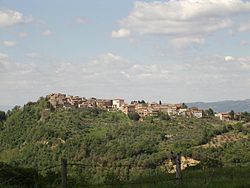Allerona
Allerona | |
|---|---|
| Comune di Allerona | |
 | |
| Coordinates: 42°48′47″N 11°58′26″E / 42.81306°N 11.97389°E | |
| Country | Italy |
| Region | Umbria |
| Province | Terni (TR) |
| Frazioni | Allerona Scalo |
| Government | |
| • Mayor | Sauro Basili |
| Area | |
| • Total | 82.61 km2 (31.90 sq mi) |
| Elevation | 472 m (1,549 ft) |
| Population (30 April 2017)[2] | |
| • Total | 1,762 |
| • Density | 21/km2 (55/sq mi) |
| Demonym | Alleronesi |
| Time zone | UTC+1 (CET) |
| • Summer (DST) | UTC+2 (CEST) |
| Postal code | 05010 |
| Dialing code | 0763 |
| Patron saint | St. Ansano |
| Saint day | December 1 |
| Website | Official website |
Allerona is a comune (municipality) in the Province of Terni in the Italian region Umbria, located about 50 km southwest of Perugia and about 60 km northwest of Terni.
Wartime tragedy
On 28 January 1944, during World War II, the Orvieto North railway bridge at Allerona was the site of the inadvertent bombing by the American 320th Bombardment Group of a train filled with Allied prisoners.[3] Most of the POWs had come from Camp P.G. 54, Fara in Sabina, 35 kilometres to the north of Rome, and had been evacuated in anticipation of the Allied advance. One of the men on the train, Richard Morris of the U.S. Army, had been captured at Venafro, imprisoned at Frosinone, sent to P.G. 54[4] and had been put on the train, which was presumably heading to Germany. In his memoirs, Morris wrote that the train was halted on the bridge over the river when the Allied bombs started to fall, and that the German guards fled the train, leaving the prisoners locked inside. Many, including Morris, escaped through holes in the boxcars caused by the bombing, and jumped into the river below.[3] Anglo-American historian Iris Origo wrote in her diary, War in Val d'Orcia, that "some of the carriages plunged into the river: there were over four hundred dead and wounded."[5]
References
- ^ "Superficie di Comuni Province e Regioni italiane al 9 ottobre 2011". Italian National Institute of Statistics. Retrieved 16 March 2019.
- ^ All demographics and other statistics: Italian statistical institute Istat.
- ^ a b Dethick, Janet Kinrade (21 September 2011). "The Bridge at Allerona - 28 January 1944". bombedpowtrain.weebly.com. Retrieved 22 May 2012.
- ^ The newly-captured prisoners[permanent dead link] at The Bridge at Allerona--the Camps
- ^ Origo, Iris War in Val d'Orcia: An Italian War Diary 1943-1944 Jonathan Cape, London, 1947, pp. 135-136
External links




